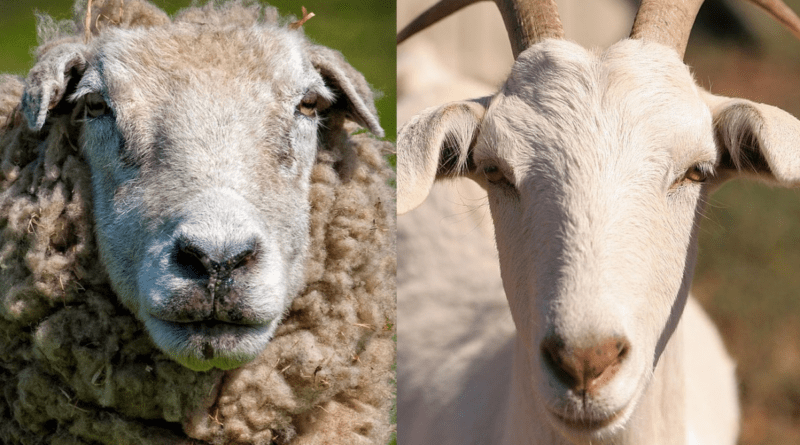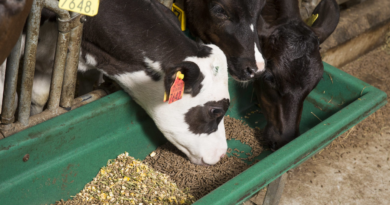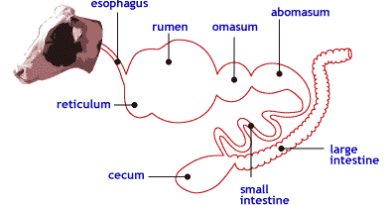Feeding and Breeding Management of Sheep and Goats
Sheep and goats are small ruminant livestock commonly raised for their meat, milk, wool, and hides. Sheep are well-known for producing wool, a valuable fiber used in textiles. They also provide high-quality meat (lamb or mutton), which is a significant protein source.
Sheep are primarily grazers, preferring grasses and short, tender plants. Sheep are generally docile and have strong flocking instincts, making them easier to manage in groups.
On the other hand, goats are versatile, providing milk, which is often used to make cheese and other dairy products, as well as meat (chevon or kid) that is lean and nutritious.
Goats are browsers, meaning they prefer to eat a variety of plants, including shrubs, leaves, and weeds, which can help manage brush and invasive plant species. Goats are curious, independent, and can be more challenging to contain due to their climbing and jumping abilities.
Both species are valuable in agriculture for their ability to adapt to different environments, convert forage into valuable products, and contribute to the sustainability of farming systems through their manure, which can enhance soil fertility.
Therefore in this article, we shall be studying the feeding and breeding management of small ruminants. Poor nutrition is one of the major factors limiting the productivity of indigenous ruminant animals around the world.
To develop a viable ruminant industry, animals should be fed properly. Though sheep and goats being ruminants feed mainly on roughage (grasses, legumes, browse, etc.).
It is necessary to give them supplements to improve their production. Proper management of the breeding flock improves productivity and reduces kid/lamb mortality.
Proper Feeding Methods for Sheep and Goats

Feeding of small ruminants depends on the age of the animal, the physiological state of the animal (lactation, pregnancy), and the quantity of the roughage being fed.
For adult animals, Hay or crop residues should be provided always in addition to 1-2 kg. Animal/day of legume hay e.g. groundnut haulms, beans pod, cowpea residue. Animals at this stage need feed for maintenance. It is therefore not necessary to overfeed them.
1. Feeding of pregnant sheep/goats
In addition to the supply of hay, a farmer should feed good quality legume hay at the rate of 1.5 -2.5kg/Animal/day, or concentrate can be fed at a daily rate of 200 – 300kg/animal per day.
However, higher levels of feeding can be maintained, especially during the last month of pregnancy when the fetus grows very rapidly and causes an increased demand on the mother’s food supply. Good feeding results in the following.
1. Provides nourishment for the developing fetus and usually results in a strong kid/lamb at birth.
2. Good feeding enhances the development of the udder and ensures adequate milk production of the dow/ewe.
3. It builds up body reserves of flesh on dow/ewe.
4. It prepares the dam for the difficult task of parturition.
This practice of enhanced feeding just before parturition is referred to as steaming up.
2. Feeding of Nursing or Lactating Females
This group of animals can be fed like pregnant females but the level of feeding should be slightly increased. This is to ensure that the dam produces enough milk to feed the offspring. In addition, hay and concentrate supplements should be provided at the rate of 300 -500 gm./Animal/day.
Adequate feeding of lactating does/ewes increases the survival rate of the kid/lambs. Increases the resistance of diseases of the young ones and ensures a fast growth rate.
3. Feeding of Growers
A supplement of 0.5 – 1kg legume hay/Animal/day in addition to free choice feeding of roughage is sufficient for this class of animals.
4. Feeding of Breeding Males
When males are not in service, they should be maintained on good grazing or crop residue ad lib plus 1-2kg legume hay/Animal/day.
About a month to being used for service, they should be placed on good grazing or crop residue plus 300gm of concentrate mixture. This practice of enhanced feeding before breeding is referred to as flushing.
This has the following advantages:
1. In males, it increases the quantity and quality of semen produced.
2. In females, it increases the number of ova shades.
3. Ensures a greater chance of turning/triplets in the dam.
4. Increases the conception rate.
Care should be taken to prevent the overfeeding of the male as this will lead to fattening which is not desired in breeding males.
Read Also: Techniques Involved In the Storage of Collected Semen in Animal Breeding
Breeding Management of Sheep and Goats

The reproductive activity of sheep and goats is stimulated by variations in the day length. In the Northern hemisphere, where day length varies with the season of the year, oestrus takes place mostly from July to October as opposed to the tropics where there is only little variation in the length of day and the oestrus cycle reoccurs through the year.
Does/ewes come on hest (oestrus) at regular intervals of about 18-21 days if not bred (Oestrus cycle). The oestrus period (the only period the female can accept the male) lasts for about 3 days or 72 hours.
Signs of Oestrus
The signs of oestrus include the following:
- Uneasiness.
- Frequent urination.
- Tail shaking.
- Swollen Vulva with a little mucus discharge.
- Sometimes the female could be seen mounting other animals themselves.
- Bellowing.
Mating Methods in Sheep and Goats
There are two main mating methods in sheep and goats, which include the natural method and the artificial insemination method as discussed in detail below.
1. Natural Service (Natural method)
This involves the natural copulation of the buck/ram to a doe/ewe. In Nigeria for instance, where most females and males are kept together there is no restriction to mating.
However, in cases where females are kept separately from males, careful observation particularly in the early morning should be carried out to notice females on heat to breed them..
2. Artificial Insemination
Artificial insemination (AI) in sheep and goats is a reproductive technology used to impregnate females without natural mating. It involves collecting semen from a male (ram or buck) and manually introducing it into the reproductive tract of a female (ewe or doe).
This technique allows for selective breeding, genetic improvement, and the dissemination of superior genetics across herds, thereby enhancing productivity and genetic diversity. AI also facilitates biosecurity by minimizing the spread of sexually transmitted diseases among livestock.
However, this has recently been given more attention but is rarely practiced in some parts of the world like in Nigeria for instance due to the following challenges:
1. There are not enough semen banks.
2. Lack of chemicals for large semen preservation e.g. solid nitrogen.
3. Lack of enough proven males.
4. No adequate technical know-how.
Read Also: Popular Breeds of Ruminant Animals
Management of Breeding Does/Ewes

The management of breeding females is divided into three main phases.
1. Dry period (the period between weaning to gestation)
This usually lasts about three months. The doe or ewe is least productive at this period. It is a time the dam recovers from the stress of the previous pregnancy and lactation. It is also a time when the dam prepares for the next pregnancy period, ewe/does should be given a higher plane of nutrition.
Flushing results in higher/lambing percentages. For mating the ratio of buck/ram to do/ewes is 1:20- 40. Hand service (isolating females on heat and introducing them to males) can increase the number of females to 50 under intensive management.
2. Pregnancy (gestation) period
This refers to the period between successful mating to parturition) in sheep and goats period is about five months.
Fetal development in the first three months of pregnancy is normally slow hence to make appreciable increases in feed supply. In the last four to six weeks before parturition and quality of the feed given should be increased.
This is done to meet the nutrient requirement of the fetus as well as the dam. This enhanced feeding at period (just before parturition) is called steaming up. Steaming up ensures the following:
1. Greater development of udder tissues and high milk-yielding potential for the dam.
2. Low dose/ewe and kid/lamb mortality.
3. Higher live weight gain in the young thus heavier adult stock.
However, it is important to note that water and minerals should be provided at all times to the animals.
3. Lactation period
Feeding of the lactating is aimed at increasing milk production to meet the needs of the offspring. Normally the feed requirement of a lactating female is greater than during pregnancy.
Signs of kidding/lambing
1. Udder Enlargement: There is a significant change in the size of the udder close to parturition.
2. Lack of interest in grazing: The female appears not to show any interest in grazing and legs behind the flock.
3. The vulva appears slightly swollen with some mucus discharge.
4. Uneasiness i.e. restlessness.
5. The animals constantly standing up. Sitting down and smelling the ground.
When the female is in the process of paturition it should be allowed privacy. Assistance should only be given when there are obvious signs of difficulty at which time a veterinarian should be invited.
Management of Kids/Lambs
The dam should be allowed to suckle kids/lamb immediately after birth. This is because at this time the dam’s milk contains colostrums. Colostrum contains antibodies that help to confer initial immunity to the kid/lamb, it also stimulates the alimentary system. Colostrum production ceases around the third or fourth day after parturition.
It is important to check the test of the female to ensure that milk is available for the kid/lamb. If the dam’s milk supply is low, the kid may have to be fed with an alternative milker replaced or placed with a foster mother.
Gentian Violet (G.V.) which is is an antiseptic dye used to prevent infections in cuts, wounds, and the navels of newborn animals should be applied to the cut naval of the young to prevent infection.
Weaning can be done between 4 weeks to 3 months depending on age breed and purpose. However, weaning below the age of 3 months is not advisable for tropical sheep and goats. Weaning can be encouraged by the provision of creep feed. The young animal normally begins to nibble at solid food such as leaves. Grasses at 2-3 weeks of age. Where a dam dies immediately after parturition artificial colostrums should be provided.
Artificial colostrums are made up of:
- 0.61 litre of cow’s milk.
- 1 teaspoon of castor oil.
- 1 teaspoon cod liver oil.
- 125mg of broad-spectrum antibiotics.
Normally a quarter (1/4) to 1 liter of artificial colostrums is given per day for four days.
In summary, adequate Feeding of small ruminants is necessary for improved productivity. The notion that ruminants can eat anything and should therefore be allowed to scavenge results in poor performance and low economic returns.
Improper management of breeding flocks results in the high mortality rate of the young in particular and adults in general. Proper feeding is one of the important factors in small ruminant production. the feeding of small ruminants varies with the age or physiological state of the animal.
The management of the breeding flock is divided into three phases, depending on the different physiological states of he female. Young kids/lambs should be properly cared for to ensure their survival and optimum growth.
Read Also: How to Store Fresh Fruit, Vegetables and Herbs









